Spring Tutorial for Java Aspirants
The Spring Framework is a well-liked choice of software developers for creating large applications. This Spring tutorial provides you with comprehensive knowledge of how to build enterprise-level applications using Java with the Spring Framework.
Introduction to Spring Framework
This Java platform called Spring Framework offers complete infrastructure support for creating Java applications. So that you can concentrate on your application, Spring handles the infrastructure. We cover the following in this spring tutorial:
- Overview of Spring Framework
- The Need for Spring Framework for Organizations
- Multi-Environment Support with Spring Framework
- Dependency Injection
- Modules
- Spring Usage Scenarios
- Advantages of Spring Framework
Overview of Spring Framework
You can use “plain old Java objects” (POJOs) to create applications using Spring, and you can attach enterprise services to POJOs without altering them. The Java SE programming model, as well as full and incomplete Java EE, are all compatible with this capability. Our core Java training in Chennai helps you gain expertise in the fundamentals of Java.
Here are some examples of how application developers like you might benefit from the Spring platform:
- Make a Java function operate as a database transaction so that you don’t have to deal with transaction APIs.
- You can transform a local Java method into a remote process without having to deal with external APIs.
- Create a management operation from a local Java method without utilizing JMX APIs.
- Create a message handler in a local Java method without using the JMS APIs.
Accelerate your skills with our API testing training in Chennai.
The Need for Spring Framework for Organizations
- Code deployments to testing (QA/UAT) and production environments are managed by specialized teams in organizations that must adhere to rules like SOX, PCI, and/or SAS-70.
- Less so with smaller businesses, which are unable to sustain specialized IT staff due to a lack of funding.
- Automated deployments and CI builds will be part of more contemporary development cultures.
- Continuous deployment, which is arguably the holy grail of software engineering, may even be practiced by teams at the cutting edge of contemporary software development, but in practice, it is uncommon.
These scenarios will each require a different configuration. There’s a good probability that as the breadth of your program expands, so will each environment’s distinctiveness.
The Spring Framework contains some exceptional technologies that are utilized to handle the complexity of developing contemporary enterprise applications.
Let’s start by thinking about some typical issues that arise in the many contexts that a large corporate application will need to handle.
Local Development
Running on your laptop is your development environment. We frequently witness businesses completely failing in this area.
Without the need to connect to other servers throughout the company, your code should be able to run locally.
The code should ideally be able to be executed without a wireless connection while flying at 30,000 feet.
This implies:
- An outside database is not possible to use. You won’t be utilizing Oracle’s development database.
- No communication with additional online services.
- (MQ Series, Active MQ, Oracle AQ, etc.) without JMS
- Local caching of your build artifacts is required (hi Maven, Ivy!).
The Grails team excels at providing out-of-the-box support for a local development environment.
An in-memory H2 database is automatically created when you launch Grails in development mode. Based on your domain classes, Hibernate creates the database tables.
Continuous Integration
Due to the various types of testing software they support, continuous integration servers can be difficult to configure.
- You might have a project that generates a JAR file with only unit tests and moves quickly.
- You might have integration tests that launch an embedded Tomcat instance and an H2 in-memory database as Grails does.
- Your tests may even conduct functional tests by interacting with the integrated Tomcat instance using tools like Spock and Geb.
- Furthermore, automated deployment jobs to a different specialized environment are not unusual on CI servers.
- Each of these environments is probably going to necessitate unique setup requirements for your application.
Development
Some businesses decide to have a testing environment. The development team often has control over a server environment that is similar to a production environment.
You must set up the application to communicate with the environment’s servers before you deploy it there.
QA/UAT
User acceptance testing, also known as UAT, and quality assurance, often known as QA, are testing environments for non-developer resources. Both QA and UAT may exist in some organizations, or only one or the other.
If you have both, the company likely has business analysts who work in the UAT environment and formal QA engineers who operate in the QA environment. A team responsible for configuration management frequently oversees these setups.
Developers will occasionally have access to the environment, although this is not always the case.
Pre-production or Stage
An application environment known as Pre-Production or Stage (Staging) integrates with all the production services and auxiliary databases.
- Although application code can be deployed in this environment, access to that code is restricted.
- A website may have a unique URL, access limited to certain IP addresses, or load balancer-enforced throttling.
- Although it is less frequent, certain organizations do employ this environment. Facebook uses code like this.
Production
The setting that your end customers will use is called production.
- Your business partners want to keep this environment, which handles the majority of transactions, operational at all times.
- As you can see, every one of these situations will have particular needs.
- Various database servers, versions, and frequently various database providers will all be present.
- You’ll have many auxiliary services. A payment gateway might be present on an e-commerce website, for instance.
- It might be a mock in development, a testing gateway provided by your payment provider in testing, and a distinct payment gateway in actual production.
Move ahead in your career through our MVC training in Chennai.
Multi-Environment Support with Spring Framework
Since its launch, the Spring Framework has been designed to address the difficulties of maintaining intricate business environments. The Spring Framework provides many established features that you may utilize to support the difficulties of enterprise-level apps.
Properties of Spring Framework
The externalizing of properties is well supported by the Spring Framework. Simple string values called “properties” are exported from your Java program. The following methods exist for setting properties in the Spring Framework:
Traditional Property File
Within a standard properties file. This file frequently goes by the name “application.properties” and is maintained in the resources subdirectory. Use of <filename>.properties is usual.
Using Variables from the Operating System Environment
Java can read environment variable values set by the operating system. This has worked well for me in the past for things like database settings.
In this instance, moving my build artifact between environments was simple. For the support personnel, it was essentially “drag and drop” after it was set up.
Command Line Variables
You have the option to supply command-line arguments to any Java program when it is launched. It’s practical to make your built object portable in this way.
One word of caution: sometimes, when looking at active processes on a system, you can view the command line details that initiated the process.
For password strings, this technique might not be the ideal one.
There are several possibilities for sourcing property values in the Spring Framework Support. Utilizing the Spring Expression Language (SpEL) is one method.
Enhance your Java skills with our hibernate training program in Chennai.
Dependency Injection
In general, Java applications, a broad category that includes everything from restricted applets to n-tier server-side corporate applications, consist of objects that work together to create the application itself.
As a result, an application’s objects are dependent on one another. This is known as dependency injection.
The Java platform offers a wide range of functionality for application development, but it lacks the tools to put the fundamental pieces together into a coherent whole, leaving that work to architects and developers.
The several classes and object instances that make up an application can be put together using design patterns like Factory, Abstract Factory, Builder, Decorator, and Service Locator.
These patterns, on the other hand, are merely best practices given a name along with an explanation of what the pattern does, where to apply it, the issues it resolves, and so forth. Patterns are formalized best practices that you have to use in your application on your own.
This issue can be solved by the Spring Framework’s Inversion of Control (IoC) component, which offers a formalized method of assembling several components into a usable, fully functional application.
Formalized design patterns are codified as first-class objects in the Spring Framework so you can include them in your application(s).
This is how the Spring Framework is used by many businesses and institutions to create reliable, maintainable applications.
Kickstart your IT career with our placement training institute in Chennai.
Modules
About 20 modules make up the Spring Framework’s capabilities. These modules are separated into the following groups:
- Core Container
- Data Access/Integration
- Web
- AOP (Aspect-Oriented Programming)
- Instrumentation
- Test
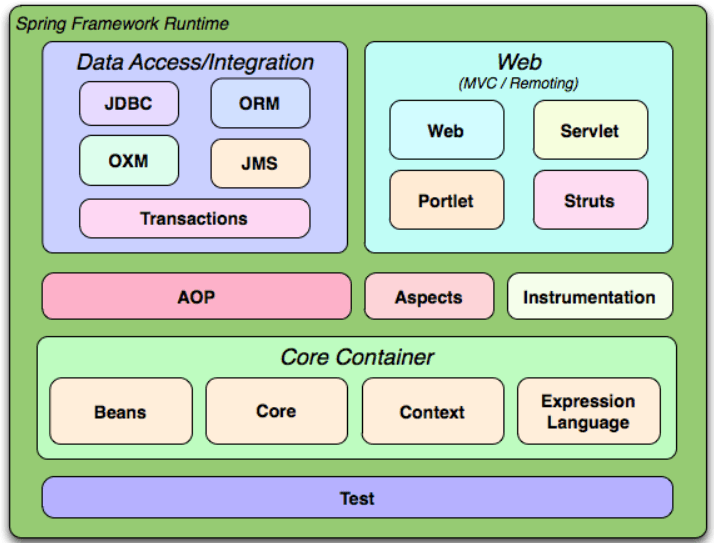
Core Container
The Core, Beans, Context, and Expression Language modules make up the Core Container.
Core and Beans
The Core and Beans modules offer the framework’s fundamental elements, such as IoC and dependency injection.
- The BeanFactory is a sophisticated use of the factory design.
- Programmatic singletons are no longer necessary, and you may now divide the logic of your actual code from its definition and set of dependents.
Context
The Context module offers a way to access objects in a framework-style manner that is comparable to a JNDI registry, and it builds on the strong foundation offered by the Core and Beans modules.
The context module adds support for internationalization (using, for example, resource bundles), event propagation, resource loading, and the transparent construction of contexts by, for example, a servlet container.
It inherits its capabilities from the Beans module. Additionally supported by the context module are Java EE technologies like EJB, JMX, and simple remoting. The ApplicationContext interface is the primary focus of the Context module.
Expression Language
For accessing and modifying an object graph at runtime, the Expression Language module offers a robust expression language.
Invoking methods, accessing the context of arrays, collections, and indexers, logical and arithmetic operators, named variables, and retrieving objects by name via Spring’s IoC container are all supported by the language.
Along with common list aggregations, it also provides list projection and selection.
Data Access/Integration
The layer for data access and integration is composed of the JDBC, ORM, OXM, JMS, and Transaction modules.
- A JDBC abstraction layer provided by the JDBC module avoids the need for time-consuming JDBC coding and error code parsing specific to each database vendor.
- The popular object-relational mapping APIs JPA, JDO, Hibernate, and iBatis all have integration layers that are provided by the ORM module.
- All of these O/R-mapping frameworks may be combined with every other Spring feature, including the previously mentioned straightforward declarative transaction management feature, by using the ORM package.
- The OXM module offers an abstraction layer to allow Object/XML mapping applications for JAXB, XMLBeans, Castor, XStream, and JiBX.
- The Java Messaging Service (JMS) package has features for sending and receiving messages.
- The Transaction module offers declarative and programmatic transaction management for all of your POJOs (plain old Java objects), including classes that implement specific interfaces.
Explore what our J2EE training course has in store for you.
Web
The Web layer is composed of the Web, Web-Servlet, Web-Struts, and Web-Portlet modules.
Web
Spring’s Web module may initialize the IoC container and provide basic web-oriented integration features including multipart file upload functionality via servlet listeners and a web-based application context.
It also includes the components of Spring’s remoting support connected to the web.
Web-Servlet
Spring’s model-view-controller (MVC) implementation for web applications is contained in the Web-Servlet module.
The Spring MVC framework, which combines with all the other Spring Framework capabilities, offers a clear division between domain model code and web forms.
Web-Struts
The support classes for integrating a traditional Struts web tier within a Spring application can be found in the Web-Struts module.
Keep in mind that as of Spring 3.0, this support has been deprecated. Think about moving your application to a Spring MVC solution or Struts 2.0 with its Spring integration.
Web-Portlet
The Web-Portlet module provides the MVC implementation for use in a portlet context while emulating the features of the Web-Servlet module.
AOP and Instrumentation
Aspect-oriented programming implementation that meets with the AOP Alliance is provided by the Spring AOP module.
- Method interceptors and pointcuts are examples of things you can build to decouple code that implements functionality that should be separated neatly.
- You may also embed behavioral data into your code using source-level metadata functionality, much as how .NET attributes work.
- Integration with AspectJ is provided through the standalone Aspects module.
- For use in some application servers, the Instrumentation module offers support for class instrumentation and classloader implementations.
Test
The JUnit or TestNG testing of Spring components is supported by the Test module. Spring ApplicationContexts are consistently loaded, and those contexts are cached. Additionally, it offers mock objects so you may test your code independently. Join SLA for the best Java training in Chennai.
Spring Usage Scenarios
In many situations, from applets to fully-fledged business applications that leverage Spring’s transaction management capability and web framework integration, the previously discussed building pieces make Spring the obvious choice.
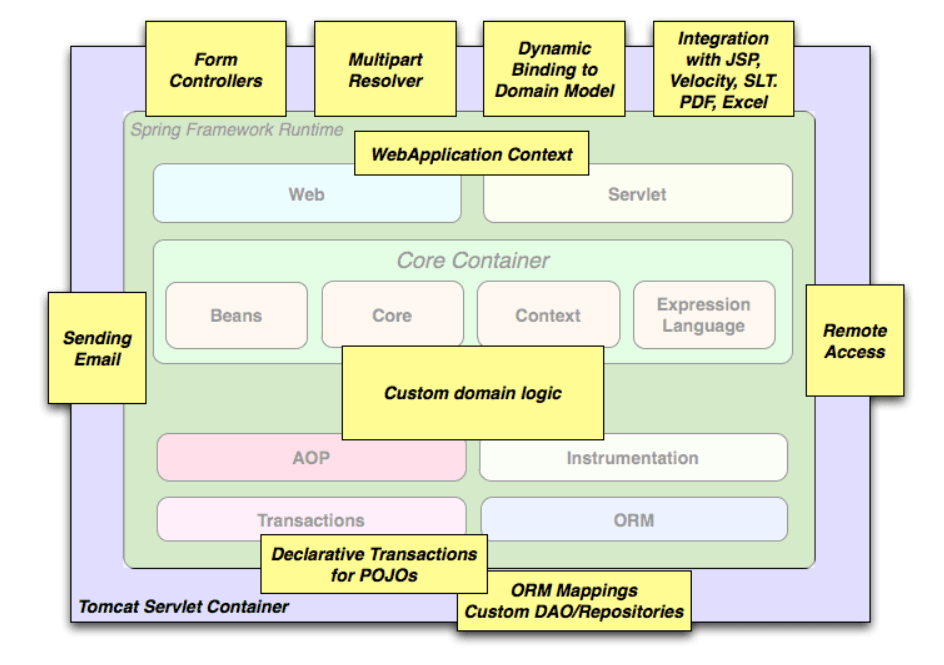
Typical Complete Spring Web Application
Due to Spring’s declarative transaction management capabilities, the web application is entirely transactional, just like it would be if you used EJB container-managed transactions.
- Simple POJOs can be used to implement all of your unique business logic, and Spring’s IoC container can handle their management.
- Support for email sending and validation that is not dependent on the web layer are additional services that let you pick where to apply validation rules.
For example, while using Hibernate, you can keep utilizing your current mapping files and normal Hibernate SessionFactory setup.
JPA, Hibernate, JDO, and iBatis are all integrated with Spring’s ORM functionality.
Form controllers replace the requirement for ActionForms or other classes that convert HTTP parameters into values for your domain model by integrating the web layer with the domain model in a seamless manner.
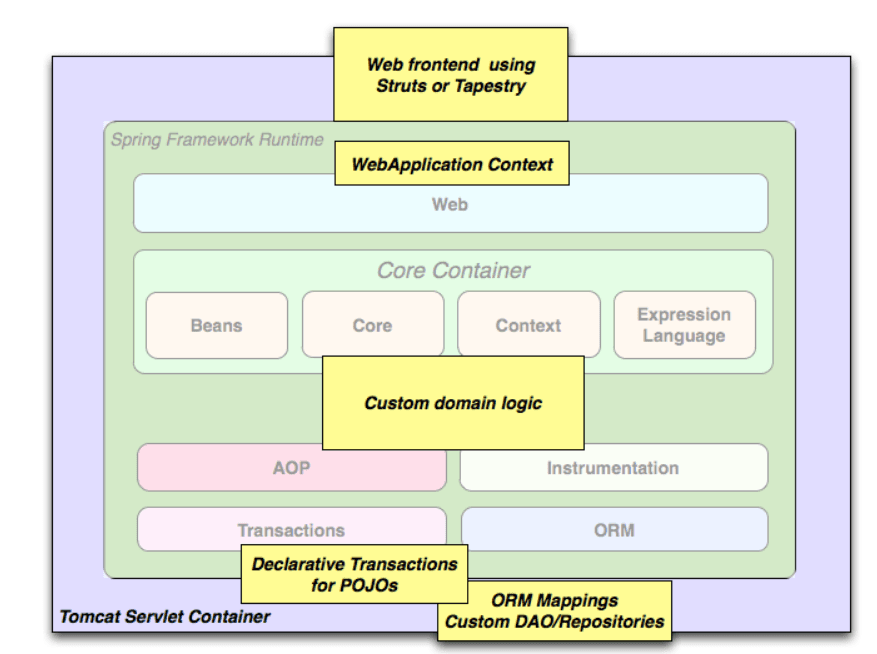
Using a third-party web framework, Spring middle-tier
You may not always be able to entirely switch to a new framework due to the circumstances.
- The Spring Framework is not an all-or-nothing proposition; you are not required to use every feature it offers.
- A middle-tier based on Spring can be linked with existing front-ends created using WebWork, Struts, Tapestry, or other UI frameworks, enabling you to exploit Spring transaction features.
- Simply utilize an ApplicationContext to set up your business logic, and a WebApplicationContext to integrate your web layer.
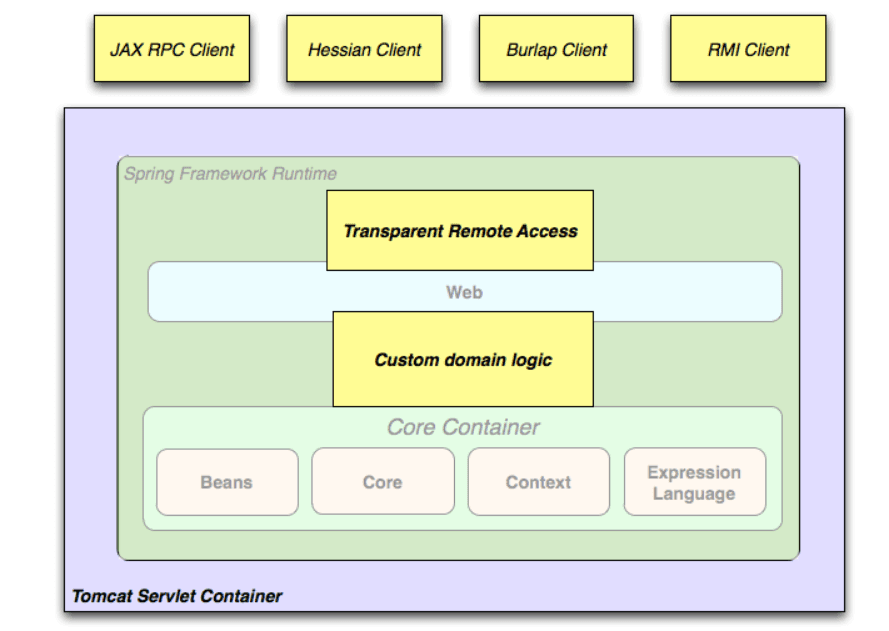
Remote use scenario
Use the Hessian, Burlap, RMI, or JaxRpcProxyFactory classes from Spring when you need to access existing code via web services.
It is simple to enable remote access to already existing applications.
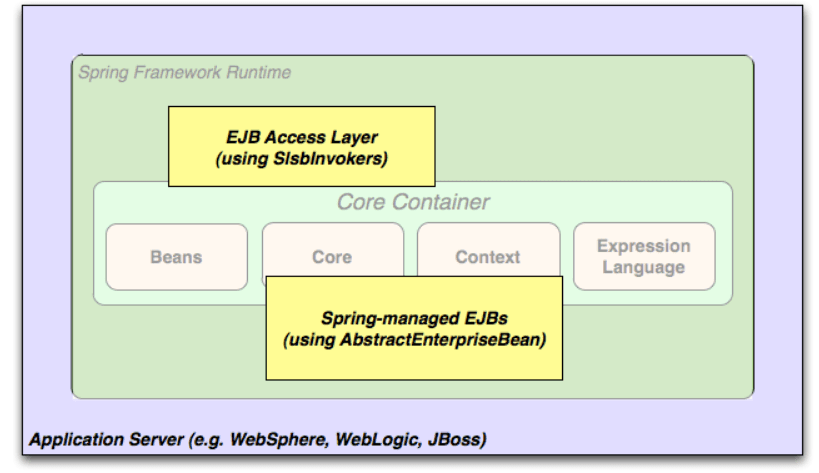
Wrapping existing POJOs in EJBs
Due to the Spring Framework’s accessibility and abstraction layer for Enterprise JavaBeans, you can reuse your current POJOs and encapsulate them in stateless session beans for use in scalable, fail-safe web applications that might need declarative security. Gain expertise with Java skills through our struts training in Chennai.
Advantages of Spring Framework
The Spring framework offers many benefits, such as:
- Dependency injection: This function facilitates the development of loosely linked, more adaptable, and simpler-to-manage programs.
- AOP: This programming style offers modularity by dividing program logic into discrete units known as concerns.
- Boilerplate reduction: Reducing boilerplate code is made easier by Spring’s aspects and templates.
- Data access framework: Spring connects with other O/R mapping programs and offers a JDBC foundation.
- Consistency: Spring provides a uniform method for configuration and programming in a variety of application types.
- Enhanced productivity: Spring Boot and other tools facilitate the rapid creation of production-ready apps by developers.
- Quick development: Spring provides the best speed for development.
- Easy testing: Dependency injection makes it simpler to test programs, and Spring offers reliable testing modules.
- Free and excellent documentation: Spring comes with excellent, free documentation.
Conclusion
Many people choose the well-known Spring framework over other Java frameworks. It’s robust and lightweight and makes using Java safer, faster, and easier. We hope this Spring tutorial helps you understand the fundamentals. Kickstart your learning journey with our spring training in Chennai.
